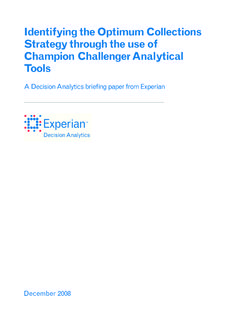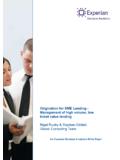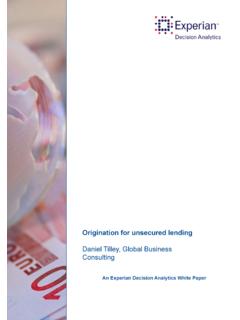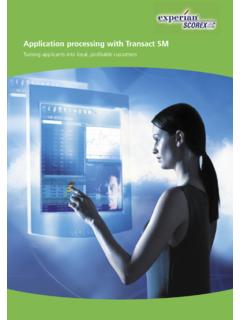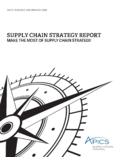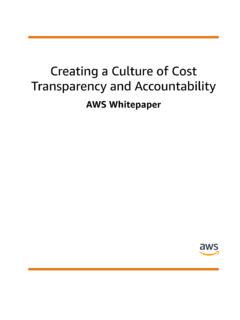Transcription of Strategy optimization - Experian
1 Strategy optimizationThe next step in credit customer decisioningRichard Turner, Head of Strategy OptimizationGlobal Consulting, Experian Decision AnalyticsAn Experian Decision Analytics white paperExecutive Summary Experian Ltd 2005continued on next pageThe next step in customer decisioning Within leading organisations credit Strategy is now acknowledged as a key differentiator in today s competitive landscape and the credit risk function is changing from one of Gatekeeper to one of Strategic Advocate . Businesses demand a far more dynamic approach to the management of customer decisions: the days of developing risk scorecards, blending with policy rules, implementing a cut off and leaving for 3 years are over! As the speed of change increases, organisations require tools, techniques and new approaches to help them to manage customer decisions. Organisations need to be able to rapidly adapt credit Strategy to changes in economic, competitive and operational environments and existing decisioning and reporting systems don t always facilitate this.
2 Over the past 25 years we have moved from credit scoring, to Strategy management and now we approach a new third phase; Strategy optimization . In order to keep up with the leaders, many organisations will need to change; Strategy optimization is the Next Step in customer decisioning. The benefits of Strategy optimizationStrategy optimization is being applied across the credit lifecycle; for new business, customer and account management decisioning through to collections and recoveries. Credit Strategy optimization from Experian Decision Analytics is delivering 5-30% profitability improvements, offering significant return on investment for forward-thinking lenders globally. However, for many organisations, the real benefits are gained through improved operational and financial management and the ability to respond to changing environments more Summary continued Experian Ltd 2005 Strategy optimization enables an organisation to improve its customer decisioning through.
3 Decisioning at a finer level of granularity - not using broad-brush segments but looking at the characteristics of each customer and tuning the Strategy to each customer s expected more factors (or dimensions) into consideration - when making a decision - not only risk, but also revenues and operational response to economic, operational or competitive environments - the ability of optimization to simulate various scenarios and predict the likely outcome means that changes to decisions can be evaluated and implemented more can be better managed - because the business has better management information and control, it can forecast future profit components and manage within these constraints more the best possible decision for the customer and organisation -through taking a holistic view of the customer decision: traditional rule based decisioning only considers one customer at a time, optimization considers the effect of other decisions in order to work within operational and financial management of key business groups - for example, optimization can identify that customers from a specific dealer or business source need to be treated in a specific way in order to meet with service level agreements or other considerations.
4 Integrating customer decisioning within the operational process - many organisations undertake analysis to determine the best customer decision and then implement it without full consideration of the operational effects. optimization enables organisations to consider these effects by constraining the number of different types of decisions (such as referral decisions) in order that these operational constraints are not violated and the business can adequately service customer optimization can be implemented within existing Strategy management decisioning solutions with minimal change to the operational decisioning process, or can be integrated into third generation Strategy management systems using dynamic individual level optimization solutions. Contents1. Background to The first credit decisioning The changing environment: the second Third generation customer Strategy optimization - the next How does Strategy optimization work?
5 How optimization works: a simplified 3. Applications of Strategy Using Strategy optimization in new Using Strategy optimization in account Using Strategy optimization in collections and 4. The components required to utilise Analytics in optimization is delivering real The challenges of 6. optimization solutions from Experian Decision About the About Experian Decision Experian Ltd 20051. Background to optimization Experian Ltd 2005 Page 420 years ago, credit decision management was far less automated than it is now. Typically, consumers who wanted a loan would approach their bank where a manual assessment of their ability to repay would be carried out. This assessment was based on several factors, which may have included the customer s age, occupation, income and even gender, relationship with the bank and previous court judgments.
6 At this time, credit scoring was in its infancy and yet to take hold; and in any event, the perceived wisdom was, People can make better decisions than computers, can t they? Perhaps the real benefit was enabling a business to reduce the cost of decisions, through faster and more objective decisioning. This resulted in improved customer service, reduced costs and enabled new businesses to enter the credit market without having to employ large numbers of scarce and expensive the years that followed, financial services organisations tapped into the opportunities created by advances in technology and formulated new approaches to decision-making. As decision support systems started to appear, Experian Decision Analytics, amongst others, developed ever more sophisticated business rules to help organisations develop and manage these complex systems. In parallel, organisations that previously would not have considered employing a mathematician developed highly trained and skilled analytical groups focusing on the management of customer data, the development of models and their deployment into operational decisioning The first credit decisioning revolution Experian Ltd 2005 Page The changing environment: the second generationThe initial decision support solutions were hard coded with little ability to change cut offs never mind scorecards.
7 Second generation solutions used Strategy management systems to help organisations manage their credit decisions more effectively. Strategy management systems enable the business to segment customers into different groups and take actions relevant to the groups or segments. This approach has been highly successful, however, organisations are constantly challenged by the complexity of the rules, the ability to maintain the rules and to accurately predict the effect of rule parallel with these changes, organisations have many opportunities to exploit their customer data and mine increased data volumes, with millions of records being analysed on PC s and analytics software readily available. Using this increased analytical power organisations are making more and more sophisticated decisions: not just yes/no decisions but determining the level, price and terms of products.
8 The result is more complexity of implementation and even greater challenges to be able to respond to changing situations. Organisations have to try to manage these complexities of customer decisioning through balancing the effect of different decisions on business targets, constraints and profitability. So, there are many factors to consider: risk, revenue, market share, capital adequacy, margins, bad debt levels and operational resource constraints. Modelling each of these elements is entirely possible with the advanced scoring techniques now available, but using existing technology it is not altogether clear how these elements should be combined to make the best decision. Whilst components within the problem are more complex, the nature of the problem is the same as it was for bank managers 20 years ago; namely, how to factor all of these different influences when making a decision on a customer?
9 Experian Ltd 2005 Page 6 Empirically based decision trees and automated decisioning have created substantial benefits for organisations worldwide - but there are limitations. Within each segment there are customers with a range of characteristics, however the action taken is the same. For example a credit limit is assigned to a group of customers within a segment, even though customers falling below the average may create more bad debt, with the organisation losing potential revenue on those above the average. Of course, the number of segments can be increased to reflect the many dimensions to customer profit but it becomes more difficult to define and manage the rule base and to monitor the effects of the actions taken. In many Strategy management systems, decision trees can grow into decision forests , which makes it even harder to implement and make changes to existing systems.
10 As a result, many organisations that use the latest technology still have the same business rules and scorecards in place that they had a number of years ago! Could it be that, while there is more data available, it is more difficult to determine how best to combine the information available to improve the decision? Perhaps it is time for businesses to reassess their processes and to use new technology to manage the complexity of customer decisions? Third generation customer decisioning Experian Ltd 2005 Page 7 Strategy optimization marks the next step in the decisioning evolution. In the same way as 20 years ago the banks needed new technologies and approaches, today s credit strategists need greater insight. As the use of analytics has increased in sophistication to manage the ever more competitive business environment, the complexity of each decision process has increased and it becomes more difficult to juggle multiple, and often conflicting dimensions as part of the credit decisioning managers need to be able to see the big picture and need to be able to make decisions which contribute to the overall success of the business.
